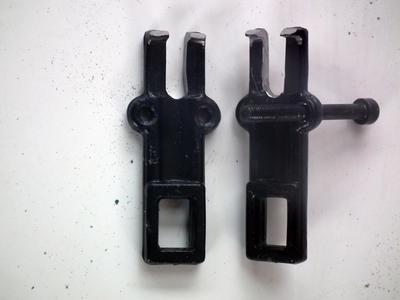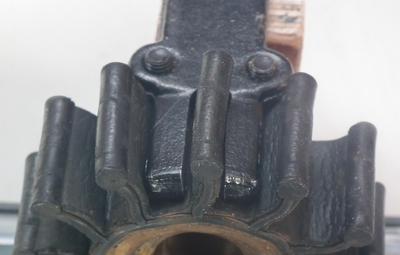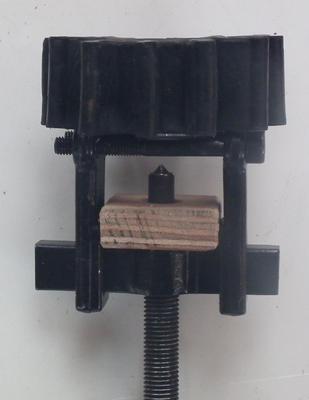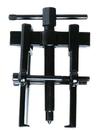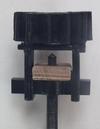- Home
- Your Sailing Stories
- Creating a Dripless Stuffing Box
Mona Island: Fools Rush In (1985)
by George Kent Kedl
(Albuquerque, NM, USA)
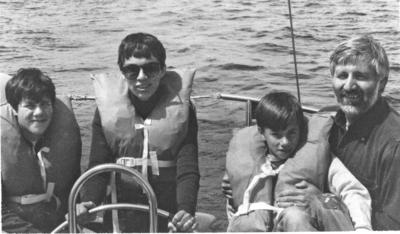
Kedl Family in 1984 (Jake, Pam, Andy, and Kent)
A member of the Ponce yacht club urged us to visit Mona Island, a nature preserve managed by the Puerto Rican Department of Natural Resources and located between Puerto Rico and Hispaniola. Its only residents were park rangers. He had often sailed to this delightful place, and his instructions for getting through the break in the reef seemed simple and straightforward. The anchorage was inside the reef on the western side of the island, and because the winds typically came from the east, it was usually protected. As we approached the reef, we lined up the third palm tree from the left with the stick in the water we thought was the mark. Pam was on the bow watching the water when suddenly the reef rose straight up from the bottom. We barely skimmed over it. The depth sounder read zero.
Then, just as suddenly, we were floating in fifteen feet of crystal-clear water above sugar-white coral sand studded with huge coral heads. Inexperienced as we were, I do not know how we managed to maneuver between the coral heads, and anchor without swinging into any of them. We were the only boat visiting this beautiful little island. The water was so clear and calm that when we were onshore and looked back, the water was invisible, and the boat, full keel and all seemed to float in the air.
There were iguanas, birds, and pirate caves, and the weather was beautiful. We got up before dawn to watch for turtles coming ashore to lay their eggs. The rangers were attempting to restore the island to the native habitat. We spent several carefree days at anchor, relaxed and (we thought) secure; swimming, schooling our two boys, hiking, and having a good time in this island paradise.
I think our experience proved the existence of a God who watches out for fools. Even though the winds usually come out of the east, they do not always. Had the winds shifted just a little in the wrong direction, we would have been trapped. Anchored as we were, onshore wind would have driven us into coral heads and damaged, if not sunk, the boat. To anchor there for days as we did, sleeping through the night without an anchor watch, was foolish. “Fools rush in where angels fear to tread” was never truer.
George Kent Kedl is working on memoirs and letters of the years from 1985 to 2000 he and his wife Pam spent sailing in the Atlantic and Caribbean. This story is an edited passage from that book, tentatively titled 'We Ran Away to Sea'.
Electricity for Sailors: #1 Basic Electricity
by Chris Collins
(USA)
Many people are lost when electrical repairs are needed. Experimentation, finding a friend to help, and hiring a professional are usually their only options. Believe it or not, neither rocket science nor magic is needed. With a basic understanding and a few simple tools, we can use logic to find and fix most electrical problems on a boat.
This will be the beginning of a multi-part series that will begin with basic electricity then detail steps to diagnose and repair many issues on a sailboat. With a little learning, you should be able to test your battery, determine how well your charging system is functioning, repair lights, know whether your starter needs replaced, and reduce the fire hazard caused by most shore power wiring. You will not, for instance, be ready to open and repair your VHF radio or your chart plotter. Topic suggestions and questions are invited.
For the next electrical article, I will talk about batteries and charging systems. In this article, I will start with very basic electricity. All subsequent electrical articles will assume you have this basic knowledge! If after reading, things are still fuzzy, do an internet search on “basic electricity”. You will find many articles. There are many more fun things to learn than I will present here.
For our purposes, electricity will be defined as the “flow of electrons.” Electrons flow through a wire just like water flows through a hose. You just can’t see the electrons like you can see the water. We measure the flow of electrons with an ammeter and call it “current.” The unit of measure is the Ampere. When a certain number of electrons flow past a point in one second, the current is said to be one ampere. So an ampere is a rate of flow just like gallons per minute would be a rate flow through a garden hose. To measure amperes, the ammeter must be inserted in the circuit so all the current flows through the meter. Some ammeters are designed to clip over the wire and the meter is activated by the magnetic field created by the current flow.
Voltage is the pressure that pushes the electrons through the wire. Voltage is measured with a volt meter. The unit of measure is the Volt. The test leads are connected across the source or across a load. Loads are usually the devices we wish to power with electricity. A light bulb, motor, and radio are examples of a load. In most cases the boat battery is the source of electricity and a charger keeps it from running down.
All wire and devices that we power have resistance to the flow of electrons or current. Using our water hose example, resistance would be like squeezing the hose or covering some of the holes in the sprinkler. Anytime electrical current is forced through a resistance, heat is generated. Resistance is measured with an Ohmmeter or calculated with Ohm’s Law. The unit of measure is the Ohm. It is doubtful that either of us have a meter sensitive enough to measure the tiny resistance of a large battery cable, but that resistance does exist. By the way, never connect an Ohmmeter when voltage is present as it will likely damage the meter. To measure resistance, take the device out of the circuit before connecting the Ohmmeter.
Since I mentioned heat, I will briefly touch on that. Heat is measured in watts. Watts = Volts x Amps. If you know the voltage and the watts, you can quickly calculate the amps with math.
Speaking of calculating, there is a mathematical relationship between volts, amps, and ohms. It is called Ohm’s law. Volts = Amps x Ohms. If you know any two values and a little math, you can calculate the third value. Everyone should know Ohm’s Law but in truth, you don’t need it to make electrical repairs on your boat.
In review, the things you should understand and remember are as follows. Voltage is the pressure. Amperage is the current or flow of electrons. There will always be some resistance to the flow. As resistance increases the flow will decrease. As resistance lessens, the flow will increase. Bigger wire has less resistance than smaller wire. When current is forced through a resistance, heat is generated.
Chris Collins owns, sails, and maintains a Catalina 30 on El Dorado Lake in Kansas and a 45 foot ketch in Rockport, Texas.
Raw Water ~ Impeller Removal Tool
by Tony C
(UK- Grand Union Canal)
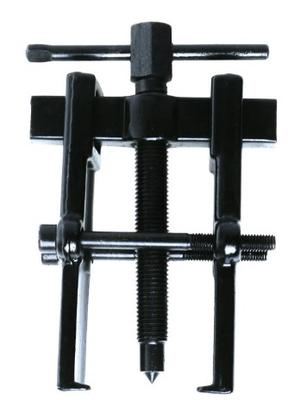
Less than $8 with free postage
The raw water pump stops pumping. It always happens at the most inconvenient time and never at the same service hours as the last one. So it’s time to contort the body into the meagre space available and replace the worn out impeller.
Removing the pump housing cover is seldom a problem, unless you drop one of the screws, which is then destined to roll to the furthest most inaccessible point in the engine bay.
Now it's time to pull the impeller out, did you remember to put 'Anti-Seize' on the shaft last time you replaced the impeller? Oh, so you didn’t do it last time, it was done by the marina engineer. Well your guess is as good as mine.
There are many home remedies to coerce a reluctant impeller to let go of the shaft:
- Grab hold of one of the vanes with pointy pliers – assuming there are some to grab.
- Lever it out with a pair of bent screwdrivers – they are going to damage the pump housing no matter how careful you are.
- Wrestle it out with 'Vice Grips'.
While you struggle someone aboard is going to ask “Isn’t there a tool for the job?”
Aah, the old 'Right Tool for the Job' premise.
Is money the solution for lack of inventiveness? Any way have you seen the price of the damned thing?
There has got to be a cheaper solution. The following cost less than $10 and only took a couple of hours.
The starting point was a two leg, armature bearing puller from the wonderful people who toil away in that engineering powerhouse, the People's Republic of China - one such company being Aliexpress.
Step 1
Slot both the puller legs;
Drill a hole at the end and hacksaw down each side;
File the four ends to provide a good sharp edge to grip into the rubber.
Step 2
Reassemble, slide down the impeller vanes and tighten the two clamping screws.
Product Improvement No.1
The square, wooden washer keeps the puller legs nice and straight.
Pros:
- Cost a fraction of the 'Right Tool';
- Twice the grip of the posh puller;
- Filled in a rainy afternoon.
Cons:
- As puller legs are directly opposite each other it only suits impellers with even numbers of vanes.
Still want to buy the 'Real' one?
Click here to read or post comments
Diesel Fuel Systems
by Bill McNatt
(AZ)
Interestingly enough I have never set foot on a sailboat or any other kind of boat for that matter.
I was born and raised in Arizona where we lack both water and wind. What I do know is diesel engines and systems. I have taught diesel technology at UTI and worked in the industry most of my adult life.
I have been able to retire at age 57 and after two months of this it is time to get off my duff and do something different and exciting.
My daughter recently relocated to Florida and I got to help her move (lucky me) when i got there I was intrigued by the sailboats, their beautiful lines and 'ready for adventure' attitude.
I started reading everything that I could about them and even downloaded a few books on Amazon hoping it would quench my thirst so to speak, but to no avail. The one thing in all my reading so far that I found lacking is fuel system maintenance.
It is important to keep your fuel tank as close to full as much as you possibly can. This will keep air and moisture out of your system. These are the enemyies of your fuel system, so if you are carrying five gallon jugs of diesel topside and you have room in your fuel tank, top it off. It will not only lower your center of gravity it will save your fuel system.
Another tip is to fill your filters with ATF when changing them. It keeps that nasty diesel smell off your hands and ATF (Automatic Transmission Fluid) is mostly solvent and will clean your injectors.
If you like this tip I have plenty more especially for Perkins diesel engines.
Biker Bill
Click here to read or post comments
My best trip ever!
by Tony Davis
(Logono, Switzerland )
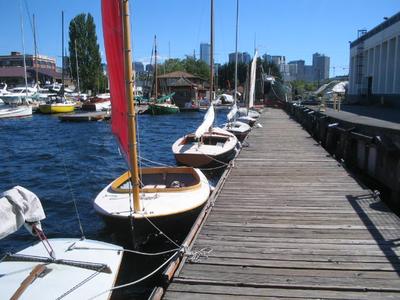
Long ago, just after retiring, I went to be a beach-bum in Mexico. I thought that would be nice after working like a fool for tooo many tears!
One afternoon, having been surfing most of the day, I went to have a nice cool beer. The pub was not very busy at the time, so I just might of had more than one? Anyhow, as I watched the sun set in to the water(Sea of Cortez), I thought it might be nice to sail my little day-sailor over to San Felipe, on the Baja.
We used to race our winter series there, when I was with the Hobie Fleet. Franks Restaurant, has a wonderful fish and shrimp dinner and it sounded like a nice trip for that reason.
I thought for a while, and figured 2 days over, and 2 days back? That would be if the wind holds up. I got up the next day, and the wind was howling like mad, big waves. But I was able to get my very small sailboat off the beach and only took on about 30 buckets of water. So it didn't take me all that long to bail most of it out. I did have to bail a bit later, because of the very big waves that kept coming over the front, but it didn't slow the boat down very much! But I was able to make the trip over in just one day!
I need to shorten this story up a bit! Well, after 4 1/2 months, I got back to the mainland! Not saying, I made it all the way to Cobo, sailed across, to the mainland, then up the coast home.
The crazy thing is, I left with $150, 4 1/2 months later, I still had a bit over $75 in my pocket, Figure that would you! It will be very hard to beat that trip, hence the title.
PS. I am writing a book about that trip. It should be a lot of pages! Just might take me a few years, because I sail most of the time, and only get to write some nights, when I have a very nice cove to anchor in over-night.
Happy Sailing Capt.
Tony Monotony
Click here to read or post comments
'Meteor' Sails North Across the Atlantic ~ May 2012
by Steve Izac
(UK)
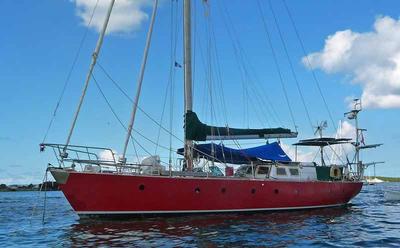
Meteor at Anchor, Simpson Bay, St Maarten
After a good saturday night out,steak dinner and too much rum with Mike Quinn and others,Sunday morning was a bit hazy...that's how I like to start a voyage!!
Weather looked ok; usual checks,start the engine and drag up the anchor after 4 months of sitting in St.Maarten. I'd had the bottom scrubbed the day before,so all the barnacles where on the bottom of the lagoon - best place for them!!
Motored out through the bridge,into the slight swells of the Caribbean sea. Checking everything, particularly the stern gland as I had done some work on it, and you never know until you're out there!!
Sails up and and gently sliding along in the lee of the Island,and then up past Anguilla, a few offlying Islands and THERE ahead - the open Atlantic...
The first week, wind right hard on the nose and blowing F6, but "Meteor" comes in at 24tons, she just plows through it and it's even comfortable down below. I slowly get into my routine of cooking,eating and sleeping...
Now...this year,the Azores high is either at a very low latitude or non existent, allowing the lows coming out of the Carolinas to track further south than usual.
I listen to the Ham net on the HF reciever,when you are singlehanded, it's a comfort to hear you are not the only idiot out there!! I also use this to get weather faxes on the laptop. The weather is really messed up this year...even tropical depressions are forming, not good news!
3 strong blows before I get to the Azores(one at 48knts), but after 22 days, I arrive in Horta with very little damage.
After a week of hanging out and shopping, I leave for Portugal, approx 1100 miles. Not much wind for the first few days, have to motor sometimes just to keep some steerage, eventually I pick up the Portuguese trades and 9 days later, after lots of shipping - thank God for AIS - I'm on the Algarve!!
'Meteor' is a Hartley 43' Cutter rig sloop, ferro construction. Very strongly built to cruise anywhere in comfort!
Me...we'll I've been cruising for many years and just can't settle down, I'll probably set off somewhere again soon...
I'm a singer/songwriter. You can check out my Album online at "CDBaby", "Itunes", "Amazon" etc. It's called "Fantastic Voyage" by Steve Izac....check out Fantastic Voyage where you can hear me warbling!!
Like it? Then buy the album here!
Click here to read or post comments
Creating a Dripless Stuffing Box
by Chris Collins
(USA)
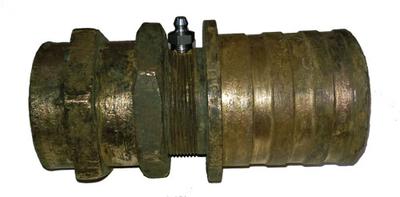
Pic showing the location of the grease fitting in the stuffing box
Modern dripless propeller shaft seals work great, but they can be expensive. If they fail, they cannot be serviced without a haul-out. Some ocean cruisers report this to be a disadvantage, preferring the ability to replace the packing in their stuffing boxes while at sea. I suggest that none of us like having seawater leak into our bilge.
Judikay and I have two sailboats, and I have modified the stuffing box on each to accept marine grease on the seawater side of the packing. Seawater pressure keeps the grease against the packing. The shaft seal in each boat is now dripless and well lubricated.
The cost of the modification was near zero! In my research, I learned this method is common in the UK and nearly unheard of in the US. Note, most automotive grease is soap based and should not be used where it might contact seawater.
The shaft log on our Catalina 30 is fiberglass. Since fiberglass made with polyester resin will absorb moisture, I was concerned about grease being absorbed and weakening the structure. I sanded the inside of the shaft log and then applied multiple coats of epoxy as a barrier coat.
Our ketch has a stainless steel shaft log with the cutless bearing pressed into the outer end of the tube. Greasing the stuffing box also greases the cutless bearing and fills the clearance between the shaft and the bearing. The cutless bearing is normally lubricated with seawater. That works great until the critters plug the intake ports, blocking the seawater. Then both the shaft and cutlass bearing suffer wear from extra friction.
On each boat, I replaced the connecting hose with the extra strong “Buck Algonquin” connecting hose. My jury is still out on how the marine grease will affect the hose. I used stainless steel grease fittings (Zerks) that are threaded with 1/8 NPT. A tap can be obtained at most hardware stores.
I installed the grease fitting as far aft as possible leaving just enough room for a wrench. I keep a spare fitting and a wrench on board. If the adjusting nut should reach the fitting when tightened, I will add more packing.
See the photo above for the location of the grease fitting in the stuffing box.
Our ketch had sat, and does sit for months without the engine running. The previous owner had replaced the propeller shaft, and yet I found it corroded under the packing. This was a classic case of being wet with saltwater and lacking oxygen.
I have learned this is very common when the propeller shaft does not rotate regularly. Our local propeller shop was kind enough to smooth the corroded area so I was able to postpone the expense of replacing the shaft until the next haul out. The resulting recess in the shaft makes it very difficult to install the packing. I don’t recommend the smoothing process if it will create a recess.
My next question was how would greasing the stuffing box cause or prevent shaft corrosion? I contacted Steve D'Antonio of Steve D'Antonio Marine Consulting Inc with just that question. Steve is an expert on stainless steel corrosion. Steve replied back with wonderful and lengthy information including the statement...
"Grease will not promote corrosion on a stainless steel alloy shaft as it excludes both air and water, the latter is needed for crevice corrosion to occur."
If you elect to install a grease fitting in your stuffing box, my suggestions are as follows:
Install a new heavy duty connecting hose, apply epoxy barrier coat to any fiberglass that might come in contact with the grease, and grease the packing as you install it to insure it will be well lubricated when the shaft first rotates.
Use a grease gun to pump as much grease into the shaft log as possible prior to launching - i.e. make an effort to keep saltwater in the sea by filling the shaft log with grease.
For the adjustment process, begin with a pretty loose adjusting nut. Tighten after seeing grease leak from seal. Ultimately, snug the nut so grease is not slung about as the shaft rotates, but not so tight that much heat is created.
The thick grease will create some heat, so expect warm. Too hot to touch would not be acceptable. Use your hand or an infrared thermometer to monitor closely and confirm the stuffing box does not get hot.
Use a grease gun to add marine grease frequently as needed to keep seawater in the sea and out of the shaft log. If this method does not work well for you, simply loosen the adjusting nut and let her drip normal.
Chris Collins owns, sails, and maintains a Catalina 30 on El Dorado Lake in Kansas and a 45 foot ketch in Rockport, Texas.
Click here to read or post comments
Recent Articles
-
Modern Boat Electronics and the Latest Marine Instruments
Dec 20, 25 05:27 PM
Should sailboat instruments be linked to the latest boat electronics as a fully integrated system, or is it best to leave them as independent units? -
Hans Christian 43: Classic Bluewater Cruiser & Liveaboard Sailboat
Dec 10, 25 04:37 AM
Explore the Hans Christian 43: a legendary heavy-displacement, long-keel sailboat. Read our in-depth review of its specs, design ratios, and suitability for offshore cruising and living aboard. -
Planning Your Sailboat Liveaboard Lifestyle: An Ocean Sailor's Guide
Dec 06, 25 05:18 AM
Seasoned sailors share their methodical risk analysis for planning a secure Sailboat Liveaboard Lifestyle, covering financial, property, and relationship risks.
